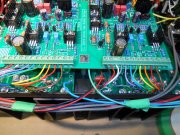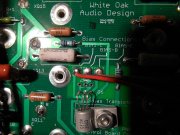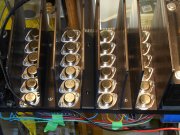All may not be well;
With inputs wired as per WO schematic, sig gen and sacrificial speaker connected, there is a load hum. A slight tingle is felt when touching the chassis or heat fins. Measured approx 60 VAC to my building ground to chassis. Voltage decreases when I touch the chassis. The (leakage) is more or less the same, 10 volts less when I reverse the line cord polarity. Voltage (and hum) are gone when a jumper is connected from the chassis to a wall outlet ground.
The transformer bolts are still insulated from transformer lams and chassis. The transformer itself is not isolated from the chassis. That would possibly require shims between the cast end bell-capacitor saddle and the lamination stack-----if this is even a solution. I gather that it is a good practice to isolate the bolts (prevent eddy currents), but has anyone had to isolate the whole transformer from the chassis?
Fluke meter reads "infinity" from the primary windings to the chassis.
I will search this forum, but has anyone had experience with transformer trouble?
Thanks again, Peter




